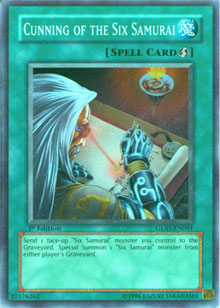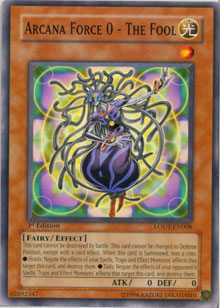The Special Summon Issue
The Yu-Gi-Oh! TCG has quite a few cards with optional trigger effects that can be activated when a monster is special summoned. The ability to activate one of these optional trigger effects depends upon how the monster is special summoned. If a monster is special summoned without using the chain, you will be fine. If you have to activate an effect to special summon the monster, it must be the first effect on the chain (chain link 1) or you will not be able to activate your optional trigger effect when the monster is special summoned.

Example 1: Bushi Return
Example 2: Call of the Magician
Player A activates Heavy Storm and Player B chains Call of the Haunted, selecting Dark Magician of Chaos. When the chain resolves, Dark Magician of Chaos is special summoned in attack position. At this time, Dark Magician of Chaos has been successfully special summoned and his effect wants to activate, but he cannot activate his effect because the chain is still resolving. Next, Heavy Storm resolves and destroys Call of the Haunted, which in turn removes Dark Magician of Chaos from play. Dark Magician of Chaos’s effect cannot be activated, because the chain ended with the destruction of Call of the Haunted and not the special summon of Dark Magician of Chaos.
The Chain Resolves
As I mentioned last week, it isn’t good when the event your optional trigger effect is looking for occurs when the chain is being built, because you aren’t able to add its effect to the chain and you won’t be able to activate it later when the chain resolves. This problem also results when the event occurs during the resolution of the chain. The event must occur when the effect on chain link 1 resolves. If it happens at chain link 2 or higher, you’re out of luck.
Sometimes effects on the chain will disappear for various reasons. What we need to remember is that these disappearing effects don’t give us a chance to activate our optional trigger effect. The event we are looking for must still be at chain link 1. If the effect at chain link 2 will create the event our optional trigger effect is looking for, it doesn’t matter if the effect at chain link 1 disappears. This rule is a newer rule for the Yu-Gi-Oh! TCG that helped address many questions we didn’t quite have answers for.

Example: First Effect Disappears
When the chain resolves, Grandmaster of the Six Samurai is special summoned. The effect of Brain Control disappears because its target is no longer face up on Player B’s side of the field, but Card of Safe Return’s effect still cannot be activated.
Simultaneous Optional Trigger Effects
When multiple optional trigger effects can be activated as a result of the same event, if their effects are activated they start a chain following the rules for simultaneous effects.
Example 1: Player A With Two Optional Trigger Effects
Player A has Poison Draw Frog in face-up defense position. He normal summons Peten the Dark Clown and activates Torrential Tribute, destroying both monsters. Since the chain ends with both Poison Draw Frog and Peten the Dark Clown being sent to the graveyard, Player A can activate the effect of both cards. Player A chooses how the two effects are ordered on the chain.
Example 2: Player A and B Have One Optional Trigger Effect Each
Player A attacks Player B’s attack-position Giant Rat with Mystic Tomato, destroying both monsters. At the end of the damage step, when each monster is sent to the graveyard, both players decide to activate the effect of their monster. Player A is the turn player, so his Mystic Tomato is placed at chain link 1, followed by Player B’s Giant Rat at chain link 2.
Example 3: Player B Has More Optional Trigger Effects
Player A activates Dimension Fusion. Player A special summons Dark Magician of Chaos and Player B special summons Red Gadget and Green Gadget. Player A is the turn player, so the effect of his Dark Magician of Chaos is placed at chain link 1. Player B’s Gadgets are then added to the chain in any order Player B chooses.
Mandatory vs. Optional Trigger Effects: Chain Building
Sometimes mandatory trigger effects and optional trigger effects will want to activate at the same time. When this occurs, the effects are placed onto the same chain, with the mandatory trigger effects placed first onto the chain and the optional trigger effects placed next. The rules of placing the turn player’s effects onto the chain first is still followed, but it becomes a bit more complicated because you have to separate the mandatory and optional trigger effects. The turn player and opponent’s mandatory trigger effects form the beginning of the chain, followed by the turn player’s optional trigger effects, and lastly the opponent’s optional trigger effects.
Example 1: Newdoria vs. Hydrogeddon
Player A has Hydrogeddon in attack position. Player B has Newdoria in defense position. Player A attacks Newdoria with Hydrogeddon, and Newdoria is destroyed. At the end of the damage step, when Newdoria is sent to the graveyard, its mandatory trigger effect activates. Hydrogeddon’s optional trigger effect can also be activated, and if Player A decides to activate the effect, it will be added to the chain with Newdoria. Newdoria is placed as chain link 1 because it is the mandatory trigger effect and Hydrogeddon is chain link 2.
Example 2: Dimension Fusion Fun
Player A activates Dimension Fusion. When it resolves, Player A special summons Copycat and Kuraz the Light Monarch and Player B special summons Arcana Force 0 - The Fool and Fire Trooper. Assuming both players want to activate their monsters’ effects, things get interesting.
Copycat and Arcana Force 0 - The Fool have mandatory trigger effects. Kuraz the Light Monarch and Fire Trooper have optional trigger effects. When the chain is built, the mandatory trigger effects are placed onto the chain first. Player A and Player B each have  one, so they are ordered following the rules for simultaneous effects. This places Copycat at chain link 1 and Arcana Force 0 - The Fool at chain link 2.
one, so they are ordered following the rules for simultaneous effects. This places Copycat at chain link 1 and Arcana Force 0 - The Fool at chain link 2.
Copycat à Arcana Force 0 - The Fool
Next, the optional trigger effects are added to the chain. They are also added to the chain following the rules for simultaneous effects.
Copycat à Arcana Force 0 - The Fool à Kuraz the Light Monarch à Fire Trooper
Looking over these effects, we see two that target (Copycat and Kuraz) and one that has a cost (Fire Trooper). Copycat and Kuraz the Light Monarch can target Fire Trooper because Fire Trooper’s effect is activated last, meaning that it is still on the field until its effect activates, but it will be removed to pay its cost and will not be of much use to either monster. (Not that Copycat does any better targeting Arcana Force 0 - The Fool.)
When the chain resolves, Fire Trooper inflicts 1000 damage to Player A’s life points. Kuraz the Light Monarch destroys Arcana Force 0 - The Fool and Player B draws one card. Arcana Force 0 - The Fool’s effect disappears because it has been destroyed and is unable to apply its heads or tails effect. Copycat’s effect disappears because the monster it targeted (it doesn’t even matter which one) has been removed from the field.
Next week we will examine more aspects of trigger effects, including their interaction with the use of priority. Until then, send all comments and questions to Curtis@Metagame.com.